The changing world order through trade blocs
By RN Bhaskar
Images created using Perplexity
The SCO meeting has just concluded. It was wonderful to see Putin, Modi and Xi shake hands and exude warmth and bonhomie. They had reason to be happy, especially Xi and Putin. Both have worked hard to make BRICS the most dynamic and relevant than other trade blocs in the world.
They have also ensured that thecentral and eastern part of the world more relevant and vibrant than the West (free subscription — https://bhaskarr.substack.com/p/the-west-stumbles-brics-in-the-ascendant). The process might have taken longer. But Trump accelerated the pace of change. Much in the same way he fast-forwarded the coming together of Russia and China, he has made China and India smoke the peace pipe and talk cooperation and progress.
Trump’s impudent handling of India made Modi revise his willingness to kowtow to the US. Remember, how Modi had acquiesced to Trump’s demands when he met him in the White House in February 2025 (https://www.bbc.com/news/articles/c23ndleveymo). The decision to challenge Thrum’s demand of allowing import of agricultural produce from the US was a subsequent development. Then came Trump’s demand for stopping import of oil from Rusia. Suddenly, India realised that it had been taken up the garden path by the US and its allies. It promptly announced that India’s PM would attend the Tianjin meet, and that set the ball rolling. At this meeting, though Modi did not join China’s Victory Day celebrations on 3 Sept 2025, the RIC (or the Russia-India China) grouping was formally presented to the world. The repercussions are still being felt.
The RIC combine can actually catalyse the shifting of the centre of gravity for global trade and commerce. I have been talking about this ever since 2009 (https://asiaconverge.com/2009/03/will-india-china-russia-dance-togetherincreasing-water-needs-will-china-dehydrate-india/ — unfortunately, the original article has disappeared from _http://www.livemint.com/Companies/wDLWbd3OWUGppEzYYC0yYO/The-Capitalist–With-increasing-water-needs-will-China-deh.html_). We continued writing about this — as a search on https://asiaconverge.com/?s=russia+india+china will reveal. We even did a podcast on this subject (https://www.youtube.com/watch?v=JSRWYUbKen8). Then came the podcast on the Republic on 31 August 2025 (https://youtu.be/okfgsdcutLo?si=hdDbWjFGIvr8yEQU). We are therefore delighted at this outcome. For India, for China and for the entire world.
But the bigger picture will be played out next year when India will be hosting the BRICS summit and Modi will the next head of this trade bloc. Of course, with the support of both China and Rusia, the summit will go off splendidly. The Indian prime minister will get his place in the sun once again.
BRICS Pay
This development comes in the face of India increasingly losing its relevance (free subscription — https://bhaskarr.substack.com/p/india-is-losing-friends-influence). One reason is that in its attempt to ensure that it did not annoy the US, India did not vote with the rest of the BRICS team on the issue of moving away from the US dollar and adopting a separate monetary system to replace SWIFT. The idea was to advance a proposal for a new international payment platform (commonly referred to as “BRICS Pay”). This would increase financial autonomy, enhance cross-border settlements, and reduce reliance on Western-controlled mechanisms for global finance. The new system would support trade in national currencies, leverage digital payment technologies. It would reduce both the cost and speed of transactions by an estimated 90%.
While most BRICS members —especially Russia and China—were strongly in favour of rapidly advancing the new platform to promote de-dollarization and financial autonomy, India voiced significant reservations. Even in March 2025 (https://moderndiplomacy.eu/2025/03/27/brics-game-changing-blockchain-payment-system-the-future-of-global-transactions/), India refused to agree to move with the adoption of the new financial system.
This stance changed in August. India decided to move against the dollar (https://www.idnfinancialspppppppppppppp.com/news/56631/india-challenges-dollar-invites-brics-countries-to-pay-in-rupees).
Fence sitting
Take another instance. The US sanctioned Venezuela, because its people elected a president that the US was not fond of, it first sanctioned its oil sales. It then ordered US oil companies to pack their bags and leave Venezuela, leaving it with huge challenges in managing its oilfields. Oil remains its main income source. Then China stepped in and decided to pick up its oil. India too had substantial oil interests in Venezuela, especially through ONGC’s subsidiary OVL. But it preferred to lie low and not raise objections. . Then the US, ostensibly to prevent drug trafficking, moved to send two warships and around 4,000 solders into Venezuela (https://youtu.be/aW88fQ-ykRQ). You could also watch this at https://youtu.be/nDl8jOX-o4s?si=AKo3i7jgdGN7DGQq, though it could be taken down.
China stepped in again, and warned the US not to use force where trade disputes exist. Russia took the matter to the UN citing rules and regulations. Even Iran joined in. The US scrapped such plans. But it attached a Venezuelan ship (https://www.reuters.com/world/americas/us-military-kills-11-people-strike-alleged-drug-boat-venezuela-trump-says-2025-09-03/) ostensibly on charges that it was carrying drugs. But all along, India has maintained silence on the Venezuelan issue.
Will BRICS warm up to India since it does not clearly take a stand on issues that the developing world faces? As a senior diplomat wryly remarks, when you sit on the fence and refuse to take sides, people often interpret this as weakness, not diplomacy.
Who’s the best?
With India joining hands with China and Russia, and being one of the co-founders of BRICS, there is bound to be a race to try to be the best trade bloc in the world. At present four key players are BRICS, ASEAN, RCEP and G7. You can get a list of their members by clicking on the hyperlinked names. At present BRICS holds out the most attractive growth. But that means it will rapidly displace the G7.
G7 consists of the traditionally wealthy and powerful nations. Except for Japan, all other members are from white-skinned countries. The EU is an attendee, because major countries from this trade bloc are already represented here.
It is worth evaluating various key trade blocs on several parameters:
G7 countries have been traditional exploiters of developing countries. They have been colonisers – even the US practised reverse colonisation through slavery and trade deals. However, lately, other trade blocs are catching up, faster than G7 can grow.
But the fastest growth could remain with the BRICS group. Partly because more countries continue to join this trade bloc. Partly because they have growing populations, unlike the G7 — many of its members have declining populations. It is also because synergies among the BRICS nations are improving rapidly.
If a growing population helps push up GDP (India is a prime example of this), it also brings with it the danger of per capita incomes. Larger populations whittle down per capita GDP.
When it comes to population, the G7 is likely to be a loser. Countries like Japan have an alarming low population growth. Other EU countries are also facing similar problems. USA has escaped this crisis because it has the benefit of immigration, though Trump could negate this benefit.
Most of the BRICS countries on the other hand have booming population growth. China has just recently lost that advantage. Russia has a poor population density but is working hard to revive this growth. Its biggest crisis was the second world war, where it lost more people, soldiers and civilians, than any other country. China suffered the second largest casualty numbers, followed by Germany (https://en.wikipedia.org/wiki/World_War_II_casualties).
But most other developing world countries did not suffer casualties. This factor — and booming births — have ensured that both BRICS and ASEAN have surging populations. That should have crippled per capita growth rates. But it has bucked the norm. It means that the rate of their income and wealth generation has been greater than the rate of population growth.
Give these two trade blocs some time, and their rates of economic growth will climb with more synergies that the respective groupings unleash. It is disadvantage G7.
When it comes to exports, the G7 and RCEP trade blocs already have a head start. But watch growth rates. It is here that BRICS has outpaced even BRICS has started growing faster than other groups. True, its base is small. But if the growth rates climb further, it may become unstoppable. As more countries join BRICS, expect its growth rates to surge as well.
And this is obvious from the declining trade surpluses of G7 countries. So, while this is happening, BRICS and ASEAN have been gaining momentum. To be watched is RCEP, which registered the highest growth rates. It Trump has accelerated this process. Watch how Brazil is now exporting soybean to China, and Mexico sending corn to Canada.
Eventually, growth will also depend on the ability of countries to invest more in their productive capacities than trying to win favour through freebies – just as India has done (https://asiaconverge.com/2019/04/doles-elections-corruption/).
Many of the European members of G7 have almost stopped investing, because their economies are in a bad shape. Germany is a classic case (free subscription — https://bhaskarr.substack.com/p/germany-stumbles-is-limping-today) Other G7 countries are the UK and France. Italy is limping along. Even so, the GFCF number is high for the G7 grouping because of USA and Canada. But expect this number to falter, because post-Trump, the US too is in a very bad shape.
China has been helping all BRICS members to begin investing in infrastructure and through this to focus on education and economic growth. Expect this number for BRICS to go up substantially in the coming decade.
That in turn will galvanise both exports and per capita GDP.
Back to India
This is why India’s moves in SCO will be regarded as just a starting point.
- Unless India manages to prove to the world that it is an economic powerhouse, its leadership will turn out to be hollow. Today, the one front where India does well is GDP. But that is primarily because of a large population.
- On the per capita score, India performs very badly.
- Its rupee is weakening even against a weakening US dollar.
- It still does not have the courage to insist that all its gold come back to India instead of letting UK house some of it.
- India must look for new marketplaces beyond Europe and the US. It has been reluctant to do this till recently (https://www.youtube.com/watch?v=_9qzFctBV7c). This could change. The ASEAN region, Africa and South America are good places to grow new markets for trade. India should begin looking at the economy rather than merely following ideological preferences.
- It must begin making the country attractive for investments once again (today there is negative net FDI (free subscription — https://bhaskarr.substack.com/p/indias-net-fdi-is-collapsing ).
- Worse, even as investments decline, its debt is increasing (https://www.business-standard.com/finance/news/net-ecb-inflows-rise-april-june-2025-rbi-data-125083100504_1.html).
- Most importantly, it needs to create jobs. Jobs, jobs, jobs should be the mantra of every policy maker.
- But investments alone won’t create jobs. It desperately needs to improve education, which will require measuring outcomes of teaching in schools on a monthly, quarterly, and annual basis (https://asiaconverge.com/2024/04/the-indian-government-has-blighted-higher-education/). Without good education, a large part of India’s future generation will become unemployable and hence a cause for political instability.
- And yes, it needs to improve healthcare. That means having more doctors, lowering private medical education fees, and reducing the cost of medicare. The role of the government’s FSSAI in promoting diabetes in India is not much of a help (free subscription — https://bhaskarr.substack.com/p/fssai-and-its-new-nutrition-ratings). No country can be called great unless it has good healthcare.
- And it needs to improve rural prosperity. Begin with the dairy sector (free subscription — https://bhaskarr.substack.com/p/dairy-ruminations-that-make-little).
Thus, the work cut out for India is immense. Celebrating the RIC is only the first step. If India does not follow through with doing what has been described ago, it will fritter away its advantages once again.
And, yes, it needs to stop waffling. The kind of silence India has maintained vis-à-vis Venezuela is awkward. Leadership of any trade bloc is respected when countries take a stand and articulate the reasons behind the need to take such a position. India has preferred to abstain itself on many issues discussed and debated in the United Nations.
It is good that it has finally taken a position on the US dollar. But it needs to take a stand on the genocide in the Middle East as well. Ethnic cleansing is an unequivocal No-No. India must take a firm stand on this issue on the rounds of morality and humanity, let alone legality,
Can India do it? Yes, it can. But that needs political will and a willingness to jettison the ideological baggage it carries. If it does not, its ability to lead BRICS will be sorely tested. Already countries like Iran and Brazil are beginning to attract the spotlight more than India. The clock is ticking.
=======
Do view my latest podcast on the silence of the Election Commissioner and the threat this poses for democracy. You can view it at https://www.youtube.com/watch?v=xNbuXbkAbfg
———————–
And do watch our daily “News Behind the News” podcasts, streamed ‘live’ every morning, Monday through Friday, at 8:15 am IST. The latest can be found at https://www.youtube.com/live/AaK-xjpmNBo?si=wrhJwJqaMW3DVFSV



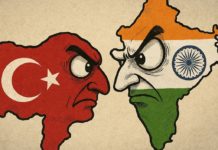
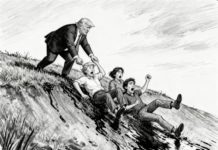



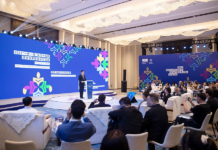



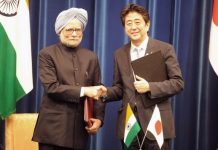
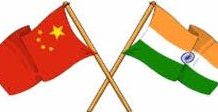

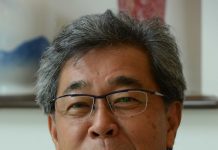




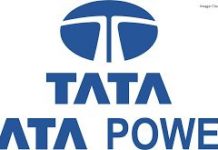
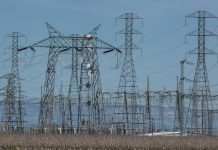
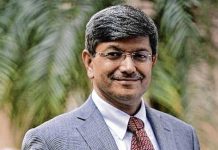



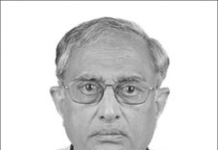

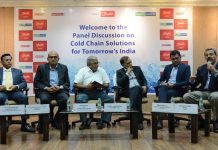
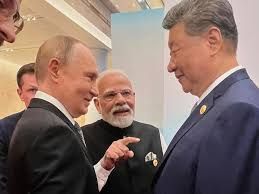

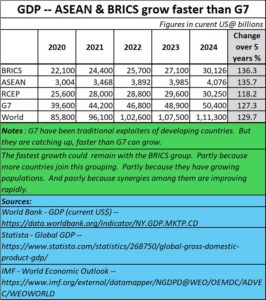
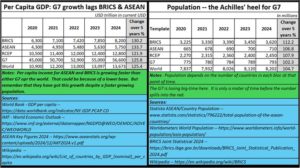
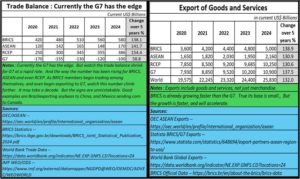
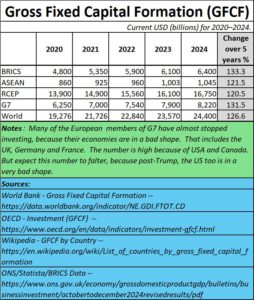







COMMENTS